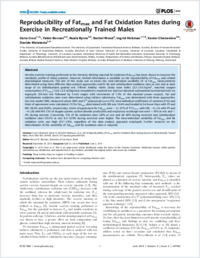Reproducibility of fatmax and fat oxidation rates during exercise in recreationally trained males
- Croci, Ilaria The University of Queensland Diamantina Institute, Translational Research Institute, Brisbane, Australia - School of Human Movement Studies, University of Queensland, Brisbane, Australia
- Borrani, Fabio Institute of Sport Sciences University of Lausanne, Switzerland - Department of Physiology, University of Lausanne, Switzerland
- Byrne, Nuala Institute of Health and Biomedical Innovation, Queensland University of Technology, Brisbane, Australia - Bond Institute of Health and Sport, Bond University, Robina, Australia
- Wood, Rachel Institute of Health and Biomedical Innovation, Queensland University of Technology, Brisbane, Australia
- Hickman, Ingrid The University of Queensland Diamantina Institute, Translational Research Institute, Brisbane, Australia - Department of Nutrition and Dietetics, Princess Alexandra Hospital, Brisbane, Australia - Mater Medical Research Institute, Mater Mother’s Hospital, Brisbane, Australia
- Chenevière, Xavier Institute of Sport Sciences University of Lausanne, Switzerland - Department of Medicine, University of Fribourg, Switzerland
- Malatesta, Davide Institute of Sport Sciences University of Lausanne, Switzerland
-
02.06.2014
Published in:
- PLoS ONE. - 2014, vol. 9, no. 6, p. e97930
English
Aerobic exercise training performed at the intensity eliciting maximal fat oxidation (Fat(max)) has been shown to improve the metabolic profile of obese patients. However, limited information is available on the reproducibility of Fat(max) and related physiological measures. The aim of this study was to assess the intra-individual variability of: a) Fat(max) measurements determined using three different data analysis approaches and b) fat and carbohydrate oxidation rates at rest and at each stage of an individualized graded test. Fifteen healthy males [body mass index 23.1 ± 0.6 kg/m(2), maximal oxygen consumption (VO2max) 52.0 ± 2.0 ml/kg/min] completed a maximal test and two identical submaximal incremental tests on ergocycle (30-min rest followed by 5-min stages with increments of 7.5% of the maximal power output). Fat and carbohydrate oxidation rates were determined using indirect calorimetry. Fat(max) was determined with three approaches: the sine model (SIN), measured values (MV) and 3rd polynomial curve (P3). Intra-individual coefficients of variation (CVs) and limits of agreement were calculated. CV for Fat(max) determined with SIN was 16.4% and tended to be lower than with P3 and MV (18.6% and 20.8%, respectively). Limits of agreement for Fat(max) were -2 ± 27% of VO2max with SIN, -4 ± 32 with P3 and -4 ± 28 with MV. CVs of oxygen uptake, carbon dioxide production and respiratory exchange rate were <10% at rest and <5% during exercise. Conversely, CVs of fat oxidation rates (20% at rest and 24-49% during exercise) and carbohydrate oxidation rates (33.5% at rest, 8.5-12.9% during exercise) were higher. The intra-individual variability of Fat(max) and fat oxidation rates was high (CV>15%), regardless of the data analysis approach employed. Further research on the determinants of the variability of Fat(max) and fat oxidation rates is required.
- Faculty
- Faculté des sciences et de médecine
- Department
- Département de Médecine
- Language
-
- English
- Classification
- Biological sciences
- License
-
License undefined
- Identifiers
-
- RERO DOC 211457
- DOI 10.1371/journal.pone.0097930
- Persistent URL
- https://folia.unifr.ch/unifr/documents/303528
Statistics
Document views: 86
File downloads:
- pdf: 189
